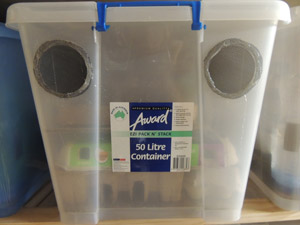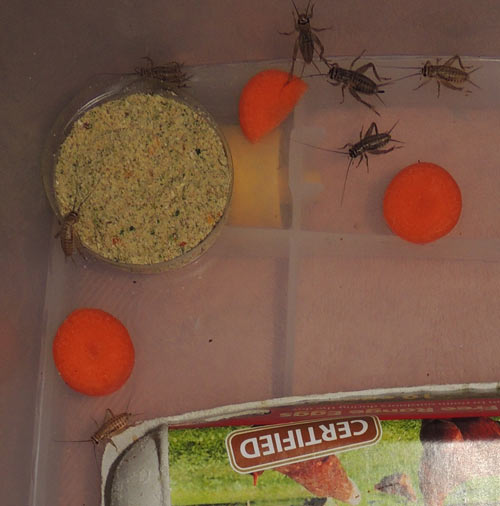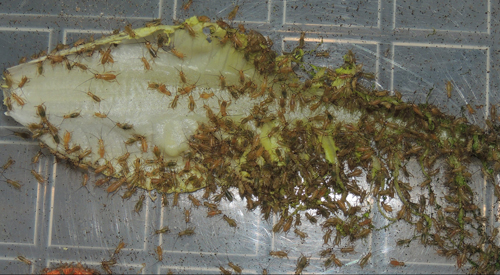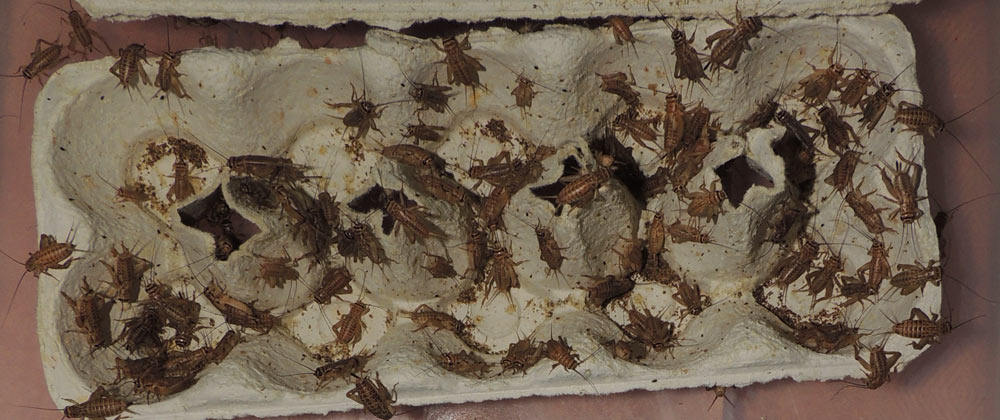How to look after your live crickets
Keeping crickets may seem hard at first but with a few simple tips and tricks you will be able to successfully keep your crickets alive and healthy. The following is a list of questions and answers that people who are new to caring for crickets often find themselves wondering.
How do I store my crickets?

Whether you bought your crickets online or at the pet store it is NOT a good idea to keep them in the container in which they came in. These containers are small and if left in one, your crickets are likely to die quickly.
Plastic storage containers are a perfect solution for storing your crickets. They come in many different sizes so choose one to suit the size and amount of crickets you have. Obviously the bigger the crickets, the more room they need.
Once you have your plastic storage container you will need to make holes for ventilation. You can do this by either poking lots of holes in the lid or cutting holes in the sides or top of the container and covering with metal fly screen (Please note this option is NOT suitable for pinhead crickets as they can squeeze through the screen). Once you have your ventilation holes, all that is left to do is to clean out the container, add your food and water sources then move in your crickets. It is a good idea to keep old egg cartons or cardboard tubes in your container to give your crickets more room and somewhere to feel safe. Your crickets should be kept in a room that maintains a temperature between 24C and 32C. If it is too cold they will eat each other or die and if it is too hot they will have shorter lifespans. 25C is an optimal temperature.
How do I stop my crickets from escaping?

Crickets are exceptional escape artists, able to squeeze through small holes and gaps. Unfortunately many of the commercially available cricket keepers have not been designed with this in mind and are therefore becoming known for escapes. Many of them have large spaces in the top of the enclosure which the crickets are able to squeeze out of, or worse, other insects are able to squeeze their way in. If you are concerned that your cricket keeper is the cause for the escapes, place it inside a tall open container or bin for a few days and check to see if you find loose crickets in the bottom. It is also possible that your crickets are escaping once they have been put inside your pet's terrarium. Most terrariums have small holes in the top for cables to go through, which are perfect for crickets to escape from. This can be avoided by placing duct tape or something similar over the holes. If your crickets are still escaping it may be occurring when you are moving them, either for the enclosure to be cleaned or for feeding.
Will my crickets breed if they do escape?
Crickets need a very particular environment in which to successfully breed and live. They need both a dry and wet source of food, moisture, warmth and to lay their eggs they need some sort of soft substrate. It is unlikely that any escapee crickets will breed in your home.
What do I feed my crickets?

In the wild, crickets are omnivores and will eat just about anything they can find. They will even eat each other! Knowing this, you should be careful of what you put into your crickets enclosure as they are likely to try and eat it. If you intend on feeding your crickets to your pet reptile or amphibian then you should try to feed your crickets on a nutrient rich diet. Crickets need both a dry and a wet source of food. Dry foods you can feed to your crickets include crushed cat food, dog food or chicken feed, mixed seeds and nuts (such as pumpkin seeds, sunflower seeds and peanuts) or alfalfa. Fresh food such as lettuce, potatoes, carrots or slices of fruit are perfect for a wet source of food.
What is gut loading?
Gut loading is the process of combining both wet and dry food types together to highly increase the nutritional value your crickets are receiving. Crickets should be given gut loads for 2 -3 days before you intend to feed them to your pet.
How do I give my crickets water?

As previously mentioned, crickets can drown very easily. For the pinhead and tiny crickets, even a single drop of water can be enough for them to drown in. To easily avoid any accidental losses, you can use slices of fresh fruit and vegetables as a source of water for your crickets. Food that contains a high amount of water such as potatoes, lettuce, spinach leaves, bok choy, kale or carrots is ideal. Fruit such as slices of orange or apple also work well. It is important that you remove any fresh food before it begins to go bad.
How and when do I clean the enclosure?
Each day you should check the crickets have clean water, remove any fresh food before it goes bad and check for and remove any dead crickets. Cleaning out your cricket enclosure should be done at least once a week. It is easy and can be done in four simple steps:
Step 1: Move all your crickets to a temporary location. (Tip: Place an egg carton or cardboard tube into your container so the crickets crawl onto it. Tip them into your temporary container. Repeat as many times as necessary. )
Step 2: Take everything out of the enclosure including food or water sources, egg crates and anything else that might be in there.
Step 3: Spray the sides and bottom of your enclosure with a cleaning agent and wipe clean. Rinse your container if necessary. Please note that you should NOT use harsh chemicals to clean your enclosure.
Step 4: Check that your container is completely dry then put in your food, water source and as many egg cartons as you think you need. When everything else is back in, transfer your crickets back!
What are egg cartons for?

Using egg cartons in your cricket enclosure increases the surface area, allowing more crickets to fit. Crickets are usually quite solitary in the wild, so the egg cartons provide them with somewhere to hide which makes them feel safe and calms them down. Crickets are happy when they have enough room and dark places to hide and a happy cricket is less likely to eat other crickets!
How do I keep my Crickets alive for longer?
It can be very discouraging for new Cricket owners to see that their crickets are dying before they have had a chance to feed them to their pet. The good news is, this is usually quite easy to fix. There are usually four reasons why crickets die sooner than expected and they are as follows:
1: Ventilation - Crickets should be kept in a spacious enclosure that also allows for air to flow in and out. Placing a screen lid on your container is a great idea as it allows for the most amount of air flow. Another option is either simply poking lots of little holes or drilling holes in the container and covering them with screening.
2: Drowning - Crickets can drown very easily, especially pinhead and tiny crickets. However you can easily avoid this by using slices of fresh fruit or vegetables that have a high water content such as potatoes, apples or oranges. The crickets will suck all of the moisture out of the fruit or vegetable slices. If you do use a water dish, it is recommended that you only fill the dish with approximately 1/2cm of water. Place a sponge inside your water dish so that any crickets that do fall in will be able to crawl out.
3: Unclean Enclosure - It is important for you to maintain a clean living area for your crickets. If any of your crickets die, they should be removed from the enclosure as soon as possible. The same goes for any old or uneaten scraps of fresh food. These need to be removed before they go bad. It is wise to avoid using harsh chemicals when cleaning out your cricket's enclosure.
4: Temperature - Crickets are very particular about the temperature of their environment. It is best to keep your cricket's habitat between 23C and 32C. If the temperature in your cricket's enclosure drops below 23C it may lead to cannibalism amongst your crickets and premature death. If your Cricket enclosure is cold, your crickets should live longer however they will grow slower. The hotter it is in your cricket's enclosure the quicker they will grow and therefore the sooner they will die.